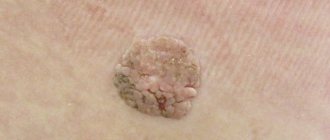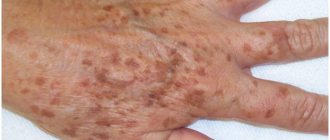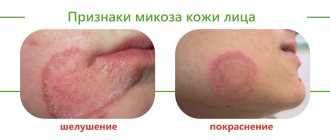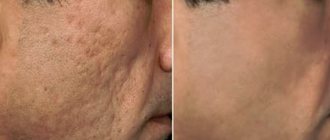REMOVAL OF NEW PLANTS
LASER KERATOMA REMOVAL
Duration of the procedure:
5-30 min.
Number of procedures:
1
Price:
from 200 rub. (depending on the category of complexity of the tumor + anesthesia)
Recovery period: 7-14 days
Equipment: CO2 laser
The number of people experiencing keratoma has increased significantly. Until now, it was generally accepted that this phenomenon is more typical for representatives of older generations who have crossed the 40-year mark. Due to age-related changes, various types of spots appear on their skin.
Today, doctors have come to a disappointing conclusion: keratoma is increasingly developing in young men and women, and moreover, in teenagers. The main cause of this problem is seen in excessive ultraviolet radiation.
Causes of keratomas
Keratoma is a benign skin growth that is flesh-colored or various shades of brown. Usually its shape is compared to a nodule, and when it grows to a plaque.
It is better to remove keratoma with a laser in the early stages. Otherwise, the surface layers of the epidermis grow, which is accompanied by peeling and, subsequently, excessive keratinization. Simply put, a crust forms, which can become cracked and even fall off, causing pain and even bleeding, so removal of keratomas must be carried out in a timely manner.
It is customary to distinguish different types of keratomas:
- senile;
- horny;
- follicular keratoma;
- seborrheic.
Keratoma occurs on the skin of men and women equally often. First of all, those areas of the body that are intensively exposed to the sun are at risk: the neck and face, hands, legs, back, etc.
Keratoma is often called the scary word “precancer.” Sooner or later, this skin tumor, increasing in breadth and depth, can become malignant. In other words, it will transform into squamous cell carcinoma.
What types of keratomas exist?
There are several types of keratomas:
- seborrheic;
- age;
- senile;
- horny;
- solar;
- follicular.
Seborrheic keratoma is an extremely unpleasant skin disease. In appearance, these are small spots of yellow or brown color, but they tend to increase in size over time, become covered with cracks, and become rough. There may be a feeling of itching and burning, as well as bleeding and pain in the affected areas of the epithelium.
Senile keratomas form in older people. They are yellowish or brown in color and can reach 5–6 centimeters in diameter. Age-related keratomas are usually raised and felt above the skin. They may have an uneven surface, as if covered with pits, resembling a thimble. Most often, these skin growths form on the neck, face and arms.
Senile keratoma usually appears in people over 30 years of age. It becomes covered with a grayish crust. A benign neoplasm is subject to constant inflammatory processes and bleeding.
Recommended articles on the topic:
- Ultrasonic facial peeling is a pleasant and beneficial procedure for your skin
- Redermalization of the skin: all the pros and cons
- Almond peeling for the face: features of the procedure
Horny keratoma gets its name because it looks like an animal horn. Typically, this variant of the skin disease is an advanced form of age-related or seborrheic type keratoma.
Solar keratoma affects those who like to abuse tanning or visiting a solarium. It forms on areas of the skin that are most exposed to ultraviolet radiation - the face, arms, shoulders, chest. Keratoma is colored gray, yellow or brown.
Follicular keratoma appears on areas of the skin covered with hair (head, face). It looks like a nodule, colored gray and reaching 1.5 centimeters in diameter. This is the rarest type of keratoma.
Timely treatment
The best way to fight cancer, one of the most terrible diseases facing humanity, is prevention. As soon as a keratoma appears, it is advisable to immediately, without delay, consult a dermatologist for laser removal. The smaller and more insignificant the skin tumor, the greater the likelihood that after its removal there will be no trace left on the body. Well, of course, such a step will significantly reduce the risk of malignant degeneration.
At the moment, only one way to treat keratoma is known - it must be removed.
This is a radical method, which can only be carried out efficiently by a qualified specialist. If suspicious growths are detected on the skin, you should contact specialized clinics and centers such as SkinLazerMed. The best option is to consult a dermatologist or dermato-oncologist.
Attempts to get rid of keratomas on your own can be fraught with the formation of unsightly scars at best, and the development of skin cancer at worst.
What does senile keratoma look like?
- Skin-colored spots and papules that are pinkish or yellowish-brown;
- The size is often up to 1 cm in diameter, sometimes merging lesions of several papules are formed;
- Often determined not visually, but by palpation;
- Present in areas exposed to the sun (fairy, back of hands, forearms);
- Signs of photodamage on surrounding skin;
- There is no sensation, sometimes itching is possible.
Initially, an oval, scaly spot appears on the skin. Localization – open areas of skin. then quickly turns into keratoacanthoma.
There are no general complaints about health.
There are 2 options for resolution: it goes away on its own, or it degenerates into a malignant form. Biopsy required!
Keratoma removal methods
There are different ways to treat skin growths classified as keratoma:
- Removal of keratoma by using liquid nitrogen.
A widespread and affordable method that allows you to remove several keratomas in one session, however, it has a number of disadvantages: rough scars remain, a long recovery period, and complications are possible.
- Removal of keratoma by electrocoagulation.
By applying layer-by-layer current to the tissue around the keratoma and the vascular walls, it is possible to prevent bleeding and infection. The crusts disappear 7–10 days after the procedure. After removal of large defects, subtle, light-colored scars remain. Small keratomas disappear without a trace.
- Radio wave method.
Recognized as milder in impact, but no less traumatic.
- Laser removal of keratoma. One of the most effective modern techniques. Its essence lies in the painless “evaporation” of the tumor by exposure to high temperature. Thanks to the cooling system equipped with the laser equipment, the patient does not experience discomfort. It does not matter where the keratoma is located. Removal of keratoma using a laser is possible on any part of the body, including the hairline. The wound heals in just 1–2 weeks. There are practically no traces left. There are no age restrictions on the use of the laser method.
Causes of actinic keratosis
The main reason is hyperinsolation - excessive exposure to UV rays of a certain wavelength: from 280 to 320 nm, i.e. UVB. Moreover, the radiation is not one-time, but regularly affecting. Breakdowns and manifestations in the form of keratomas do not occur immediately. For decades, they do not appear and the skin retains its external structure. This is the latent period of the disease . With age, the skin begins to change and a pathological focus is formed - the manifested period .
Provoking factors contributing to the formation of keratosis and its development:
Climate impact. Living in a sunny region increases the risk of development tenfold. Most often, actinic keratosis affects residents of mountains, equatorial and tropical countries.
Work outdoors.
Age. The risk of developing senile keratoma increases after 50 years of age due to hormonal and immune changes.
Phototype. People with fair skin types get sick 3 times more often than people with dark skin. It has been noted that keratomas more often occur in people with freckles.
Sunburn. A powerful provocateur not only of skin hyperpigmentation, but also of more serious dermatological diseases with the risk of neoplasms.
Keratoma removal Price
Keratoma, the removal of which by laser is relatively inexpensive, can be removed at different prices: the price range for laser keratoma removal is determined by the number of skin defects to be removed, their depth, complexity and other characteristics.
Our hair removal and cosmetology center “SkinLazerMed” specializes in a wide range of procedures that involve laser technology. We guarantee high-quality and painless keratoma removal on the same day of treatment.
How is the Laser Keratoma Removal procedure performed?
Removing a keratoma in this way is based on a laser beam affecting the affected area of the skin.
- Before starting the procedure, the dermatologist collects an anamnesis, finds out the characteristics of the patient’s health condition, possible contraindications to these manipulations, and tolerability of medications. These data allow you to determine the optimal power of the laser beam and the duration of its exposure, which allows you to perform the removal in one visit.
- A powerful cooling system is built into the equipment intended for exposure, this explains the comfort of laser keratoma removal. However, if the patient wishes, a subcutaneous injection of an anesthetic can be given to ensure that no discomfort occurs during the session.
- When it comes to a disease such as keratoma, laser removal is represented by stepwise “evaporation” of the affected tissue until the beam reaches a healthy layer of skin. During this procedure, bleeding occurs extremely rarely, but a small wound appears on the affected area. It is treated with antiseptic medications.
- The removed formation - keratoma, laser removal of which should be carried out only by a highly qualified specialist, should be monitored by a doctor for several more weeks.
The SkinLazerMed clinic will perform laser keratoma removal at an affordable price. The procedure is quick, effective and completely painless.
Keratomas: causes of appearance?
Keratoma, according to dermatologists, develops for one of two reasons - excessive ultraviolet radiation and the physiological processes of aging of the skin. The predisposition to the development of pathology, according to medical experts and geneticists, is inherited. But there are no clear reasons for the appearance of a formation, such as, for example, in condyloma, which is caused by the human papillomavirus. At one point, an accumulation of cells is observed, which leads to an anomaly.
Skin keratoma, as a rule, does not pose a threat to health. But dermatologists strongly recommend observing the spots. After all, individual formations have a tendency to reproduce and grow. And in rare cases, they degenerate into malignant neoplasms.
Laser keratoma removal - Before / After Photos
How dangerous is a keratoma?
For the most part, keratomas do not pose an oncological risk.
As mentioned above, keratoma keratoma and solar keratoma have an increased risk of malignancy. But what else is the danger of these skin formations? The fact is that even an experienced doctor is not always able to distinguish a keratoma from a malignant neoplasm using clinical methods.
Many malignant tumors at various stages of their development are similar to keratomas. Therefore, in all cases it is necessary to contact a dermatologist-oncologist; only a specialist can correctly diagnose and determine treatment tactics.
Also, keratomas can be dangerous due to complicated course. In the early stages of development, they cause only aesthetic inconvenience (which is important for women or when multiple keratomas are located in open areas of the body). But after the appearance and intensification of keratinization on the surface of the formations, additional complaints may occur - itching, pain, tingling in the area of the keratoma, with deep cracks and injury - the addition of an infection and the occurrence of inflammation, suppuration, with trauma and part of the crusts coming off the surface - severe bleeding.
To summarize: treatment of keratoma is necessary if malignant degeneration is suspected, with a complicated course, with rapid growth, as well as with aesthetic problems.
What is the essence of the laser method for treating skin diseases?
The appearance of the laser as a physical phenomenon became possible after Albert Einstein developed the theory of interaction between matter and radiation at the beginning of the 20th century. It traced ideas for the possible creation of quantum radiation amplifiers and generators of electromagnetic waves.
The first ruby laser device was designed by the American scientist Theodore Maiman in 1960. The laser wavelength was 0.69 μm. At the same time, for the first time, the properties of laser were used to destroy human hair follicles. This event became the starting point in the history of laser surgery, medicine, and cosmetology.
Laser removal of keratomas refers to both medical and cosmetic procedures. Not only hospitals and private medical institutions, but also the offices of cosmetologists and dermatologists are equipped with special devices with an attachment that generates a directed laser beam.
The medical device used in the process, using the properties of light rays and a special system of mirrors, generates a laser beam. By directing it to the affected area, the doctor ensures that the cells of the neoplasm burn from its top to the deepest layers. At the same time, coagulation of the blood vessels damaged in the process occurs, which eliminates the risk of bleeding.
After treating the tumor in this way, a barely noticeable scar remains in its place. The duration of the wound healing period is rarely more than 3-4 weeks. There is virtually no risk of wound infection during the procedure.
In the laser surgery industry, lasers with high radiation power are used, due to which they can cause significant heating of biological tissue, which contributes to its evaporation or cutting. Such an intervention, although considered surgical, is minimally invasive.
Thanks to modern laser devices and systems, during the operation it is possible to ensure:
- dry work area;
- effective contactless and contact vaporization and destruction of biological tissue;
- minor damage to surrounding tissue;
- stopping lymphatic and blood vessels;
- effective hemostasis;
- high sterility of the process;
- the possibility of combining the procedure with laparoscopic and endoscopic measures.
ethnoscience
As we can see, keratomas can be easily cleaned at home using special products. All of them are made on the basis of acids and burning chemical components. Accordingly, natural ingredients also contain acids. Therefore, you can prepare an effective folk remedy at home that can cope with keratoma. Let's look at some of the most popular recipes and see how they work.
Vinegar and onion skins
Ingredients:
- Vinegar 9% - 1 tbsp.
- Onion peel - 4 tbsp. l.
How to prepare: Wash the husks and pour boiling water over them. Dry in a well-ventilated area. Pour vinegar over the dried husks. Leave in a dark place for two weeks. Strain.
How to use: On the first day, apply a compress directly to the keratoma area for half an hour. The next day, leave the mixture on the affected area for an hour. So daily increase the exposure time by half an hour until you reach three-hour procedures.
Result: So in a week you will completely burn the keratoma. Acetic essence is a potent acid. The keratoma will be chemically burned. When using this recipe, be careful, you can burn the skin around the lesion, and even cause a chemical burn at the site of the keratoma, which can lead to scarring.
Ointment with celandine
Ingredients:
- Dry celandine - 50 g;
- Pork fat 50 gr.
How to prepare: Grind the dried celandine herb into powder. Melt the pork fat and mix the ingredients thoroughly.
How to use: Rub the keratomas with ointment three times a day.
Result: As you know, celandine also contains acids. In dry form, celandine will inhibit the growth of keratoma and gradually remove the neoplasm. Complete recovery may take a long time, up to several months.
Walnut balm
Ingredients:
- Walnut fruits - 5 pcs;
- Olive oil - 10 tsp.
How to prepare: Grind walnuts, heat the oil. Mix the ingredients and leave for a day in a dark place.
How to use: Apply the warmed balm to the keratoma twice a day for a month.
Result: The balm softens the neoplasm and relieves discomfort on the skin.
Aloe compress
How to prepare: First, prepare an aloe leaf; to do this, place it in the freezer for 5 days. Then defrost the sheet and cut it into thin slices.
How to use: Apply aloe to the keratome and secure with a plaster or bandage. Leave it overnight. Repeat the procedure daily for a month.
Result: Over time, the keratoma will shrink until it disappears completely. You can simultaneously dry the lesion during the day by wiping it with alcohol.
The above recipes have different effectiveness and duration of treatment, some are even aimed at relieving unpleasant symptoms. So removing keratoma using folk remedies is not easy. The vinegar-based recipe is the most effective, but side effects such as burns are possible.










